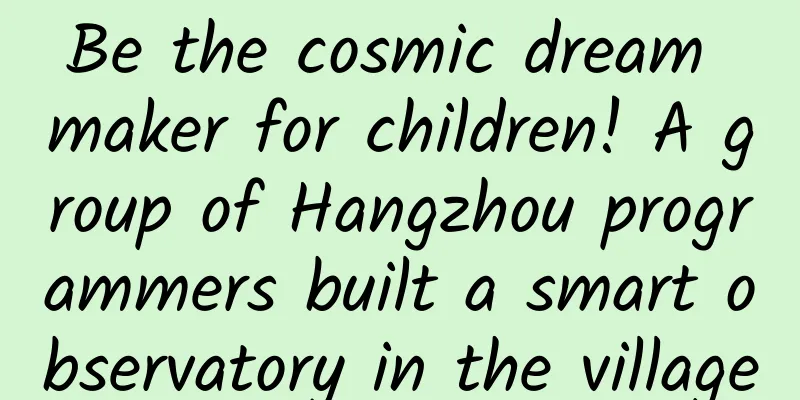Be the cosmic dream maker for children! A group of Hangzhou programmers built a smart observatory in the village

|
Programmers and the vast starry sky, two completely unrelated words, were recently connected due to the opening ceremony of an observatory located in Baizhang Town, Yuhang District. Cao Lin and Lei Bin are two programmers in Hangzhou and astronomy enthusiasts. "Uncle, when can we see our own space station?" During a teaching activity, the child's innocent question made them want to do something about it. From the plan on the PPT to the CAD modeling of the observatory's prototype, from the first time the telescope was turned on in the mountains hundreds of feet high, rotating and pointing towards the stars, to the completion of the observatory today, this group of programmers took nearly a year to bring this cosmic romance into reality. "We believe that looking up at the stars is the right of every generation and every individual." On April 27, at the opening ceremony, Cao Lin used this sentence to end the introduction of the Shen Kuo Intelligent Education Observatory. Let rural children also have a cosmic dream From public science activities to building an observatory The starting point of the observatory comes from the public welfare science popularization team that Cao Lin has been working on for many years. During a teaching activity, Cao Lin found that it was difficult to carry out aerospace and astronomy science education in rural areas, so he launched a non-governmental organization called "Go to the Sky". In the past five years, the organization has traveled to nearly 20 places, continuously carrying out various forms of aerospace public welfare science activities for rural children, grassroots people and poor areas. A few people, a car and a few boxes of equipment are often the norm. The "Set Out to the Sky" Happiness Charity Group took a group photo in Luding County. Photo provided by the interviewee In 2023, children from Luding Middle School in Sichuan Province expressed their hope to see China's own space station with their own eyes. "At the beginning, we developed a set of intelligent equipment to automatically track and photograph the Chinese space station, and the children successfully captured high-definition images of the Chinese space station. After that, we are eager to serve more rural children." Cao Lin told the Chao News reporter. Aerospace education has high barriers to entry and is difficult to implement. A campus observatory requires hundreds of thousands or millions of dollars to invest, and the equipment is not standardized enough, and the subsequent operation and maintenance costs are high. For rural children, it is not easy to see the progress of China's aerospace industry with their own eyes. Therefore, Shen Kuo Intelligent Education Observatory came into being. Why is it named after Shen Kuo? Cao Lin said that Yuhang District is the hometown of Shen Kuo, a great scientist in ancient China. Currently, it is striving to build a highland of scientific and technological innovation. Naming the observatory after Shen Kuo is to inherit Shen Kuo's scientific spirit and continuously develop new quality productivity. The observatory was finally located on the back hill of Baizhang Central Primary School in Baizhang Town, Yuhang. Cao Lin and Lei Bin said that this was somewhat of fate. "At first, we thought of finding a place on the roof, and we visited many places, but none of them could bear the load, and we also had to consider many environmental requirements such as light pollution," Lei Bin said. Guo Qingling, chairman of the Yuhang District grassroots committee of the Revolutionary Committee of the Chinese Kuomintang, heard about this idea and went to the back hill of Baizhang Primary School with his team to see if there was a way to do it. "Is this small hill possible?" The observatory was to be built on the mountain, but the infrastructure was a problem. At this time, Baizhang Town lent a hand. Chen Shizhong, secretary of the Party Committee of Baizhang Town, personally made the decision to pave a new stone road and a cement floor for the young people's dream. Now, if you walk along the path behind Baizhang Primary School, you can see this brand new observatory: its neat and eye-catching white appearance and push-pull opening and closing design show several astronomical telescopes in front of everyone. Shen Kuo Intelligent Education Observatory is also the first intelligent public science practice base in China with six major functions, including radio teaching, satellite cloud image reception, high-precision observation of China's space station and satellites, planetary imaging, deep space photography, and meteor monitoring. Unique observatory shape The inspiration actually came from the telescopic shed on Taobao Having been engaged in digitalization and informatization work for nearly 20 years, Lei Bin never thought that one day he would become the director of an observatory. "At first, I thought this might be a fantasy, but now that I've seen it transformed from a PPT into an actual observatory, I can't help but feel a little excited." Lei Bin was a little excited when recalling the bits and pieces of his experience in building the observatory. Because of limited funds, Lei Bin and his team members did a lot of homework when they first decided on the shape of the observatory. "Traditional dome observatories are expensive, so we wanted to make them as functional as possible and accommodate more equipment within a limited budget. It wasn't until we saw the telescopic shed on Taobao that we were instantly inspired and came up with the current shape." From Lei Bin drawing the first version on PPT to the team members designing and developing it themselves, and self-studying CAD and mechanical design, after 4 weeks, the plan of the telescopic observatory made of three containers stacked together was finally completed. This is also the final appearance of the observatory that everyone sees today. From the plan to the implementation, each new design once again brought new challenges to the team. How to waterproof? How to prevent freezing? The answers can only be explored again and again in experiments. The temperature in the mountainous area is extremely low at night. Once the team tested until late at night and found that their hands were stuck to the equipment. They could only breathe on it and slowly pull it out. It was under such conditions that after many tests and verifications, the design of the container finally entered factory production on the eve of the 2024 Spring Festival. Just after the Spring Festival in 2024, the back hill of Baizhang Primary School was crowded with people. This "square box" which is very different from the traditional observatory was hoisted to the top of the mountain after nearly several hours of hoisting. Afterwards, various hardware came in one after another. In order to allow each device to have a certain rotation space, everyone fully divided the space between the workshop and the telescope room, and placed the telescopes according to different task systems. Finally, in early March this year, the observatory finally entered the software debugging phase. This involved dozens of subsystems, the core of which was developed by Alibaba and Ant’s engineers Cao Lin, Lei Bin, Zhao Peilong, and Yonggu in nearly half a year. The observatory officially opened. Photo provided by the interviewee "This is mainly used to track Chinese spacecraft, turning the observatory into a 'live' observation portal for 'aerospace orbital exhibits'." Cao Lin told the Chao News reporter that although everyone is a seasoned software engineer, astronomical software is a "sinkhole". The relationship between each software is intricate, and there is no book on the market that can summarize all software tutorials. So everyone can only use the most stupid method, testing one by one, sometimes testing a version seven or eight times, and the day is already dawn after testing the software. Cao Lin still remembers the scene when everyone jumped up instantly when the first clear image of the moon appeared on the screen. "One 'Yeah' can express our deep joy." Cao Lin said that the observatory's transformation from a blueprint into reality is inseparable from the support of every partner behind the scenes. "This is the 'Shen Kuo Intelligent Education Observatory' built by programmers Cao Lin, Lei Bin, Liu Xuheng, Zhao Peilong, Fan Jianan, Zhang Wentao, Liang Suting, Lei Yong, Zhang Xu, Guo Shengfa, and the famous astrophysics doctor Liu Boyang, who spent more than a year to build." The country's first "digital human" in the field of astronomy They planted seeds about the universe in their children's hearts At yesterday's opening ceremony, in addition to the official opening of the observatory, the exclusive intelligent agent "Teacher Shen Kuo" of the Shen Kuo Intelligent Education Observatory, the first science popularization public welfare project in China based on "large model + popular science", also met with everyone. Interestingly, the appearance of this intelligent entity is very similar to Cao Lin himself. "At first, we adopted a two-dimensional design, but later we used a real-life replica method, using 'Cao Lin' as a sample, linking 'Teacher Shen Kuo' with equipment and algorithms, and finally equipped it with a large model's 'brain' to achieve data analysis, remote teaching and many other functions." Lei Bin said that through the latest large model capabilities, astronomical observation, popular science, and aerospace patriotism education are closely combined, and children can see the Chinese space station and other dream stars of China's aerospace with just a click of the mouse. After the completion of the Shen Kuo Intelligent Education Observatory, more and more children will be closer to astronomy and the universe: team member Canaan donated a 12-inch telescope free of charge. This year, he wants to take a family photo of the solar system with the children; and a cooperation across the east and west has been reached. The observatory and Luding Middle School in Sichuan Province will share the observatory's results with children in remote areas of the central and western regions through remote parallel connection; Xin Ao Music Co., Ltd. and Qin Yong, the former lead singer of the Black Panther band, also jointly created a heartwarming theme song "Painting Brush" for the "Set Out to the Sky" Charity Happiness Group and the Shen Kuo Intelligent Education Observatory, conveying this beauty through singing. The lyrics also reveal a tenderness of a tough guy: lucky lucky, the stars and the sea, we are together forever... "Lucky of course means lucky, but in fact, my daughter who is less than two years old is also called Lucky, and this is what I want for her." Lei Bin said in an interview that his work for the observatory is inseparable from the support of his wife, and in order to spend more time with his family, he took his daughter with him several times so that she could witness what her father did with her own eyes. "My original work may be far from her, but this thing can also benefit her in the future. When she grows up a little, she can be proud of me and have some admiration for me, which will give me unlimited strength." |
<<: Microplastics that may threaten health are already in the air we breathe
>>: What did you say? I can't hear you without my glasses.
Recommend
What is the price for the Jiaxing Grain and Oil Mini Program investment? Jiaxing Grain and Oil Mini Program Merchant Price Inquiry
Jiaxing Grain and Oil Mini Program investment pro...
Chun Ge, the painter, "Introduction to Human Body Painting"
Introduction to human figure drawing - character c...
Honor 50 review: A familiar swallow returns, a new work that is closely connected with Huawei
In November last year, Huawei made a bold decisio...
Operation and promotion plan after the event goes online!
First look at this picture: I divided the operati...
Artificial intelligence pioneer Marvin Minsky has passed away. Here are 7 things you should know about him
On January 24, 2016, local time in the United Sta...
Who plays Xiao He Ziqiu in In the Name of Family? Personal information of Xiao Lizhen, the actor who played He Ziqiu as a child
The TV series "In the Name of Family" i...
How to carry out fission activities well? Share a routine!
In fact, all fission activities have only one rou...
China Passenger Car Association: Analysis of the annual trend of the MPV automobile market in 2021
The full-year sales data for 2021 is out. In Dece...
Is it not suitable to get married in 2024, the "widow year"? Is the saying that "a year without spring is unlucky" true?
Today, an old folk rumor topped the trending sear...
The Amazing Abilities of Hummingbirds: How Do They Stay in the Air? What's the Principle Behind It?
Have you ever marveled at the flying skills of hu...
"Travel" certification vehicle inspection data analysis this week
In the week of late June and early July 2023, the...
World Leprosy Day丨Preventable, curable and not scary!
January 29, 2023 The 70th World Leprosy Day The 3...
Solid info! Tips for promoting the Mayu APP!
How to carry out advertising promotion on Mayu AP...
Brand promotion, how does Uniqlo create best-selling products?
Every summer’s UT campaign is the peak of Uniqlo’...
Case Review | QQ Browser News New User Retention Growth Methodology
By reviewing a growth case I did last year - the ...





![[Case] 17 pictures to understand the functional development and analysis of Meituan.com’s campus channel structure!](/upload/images/67cc40aa713ca.webp)



